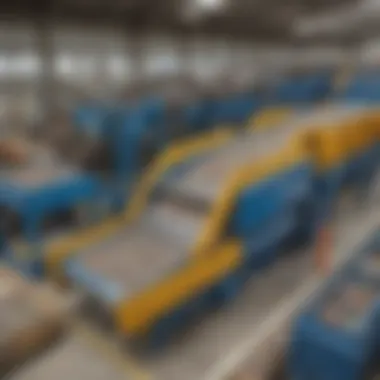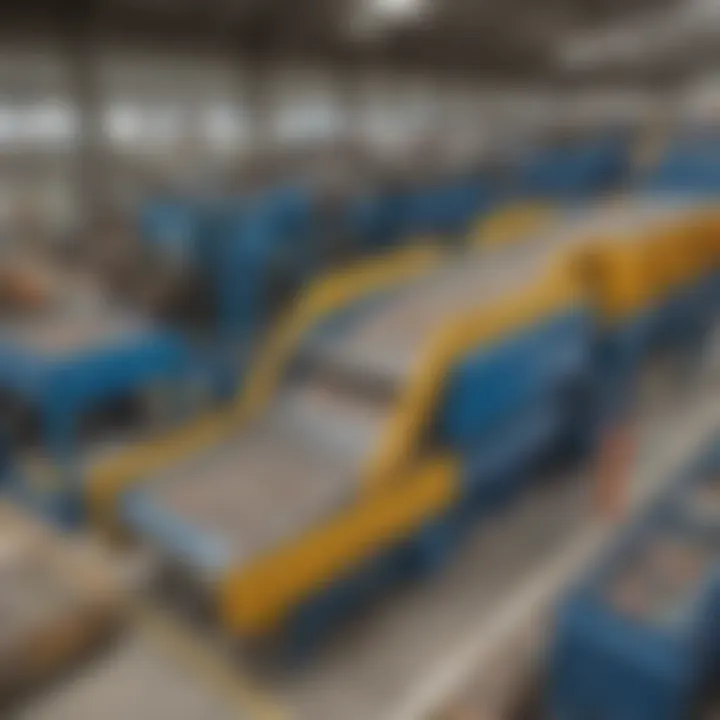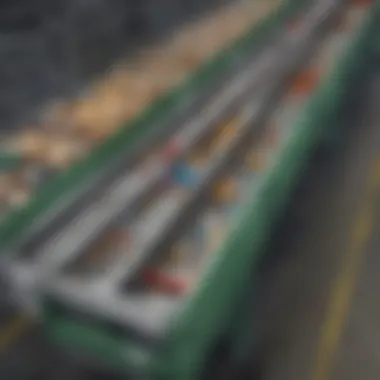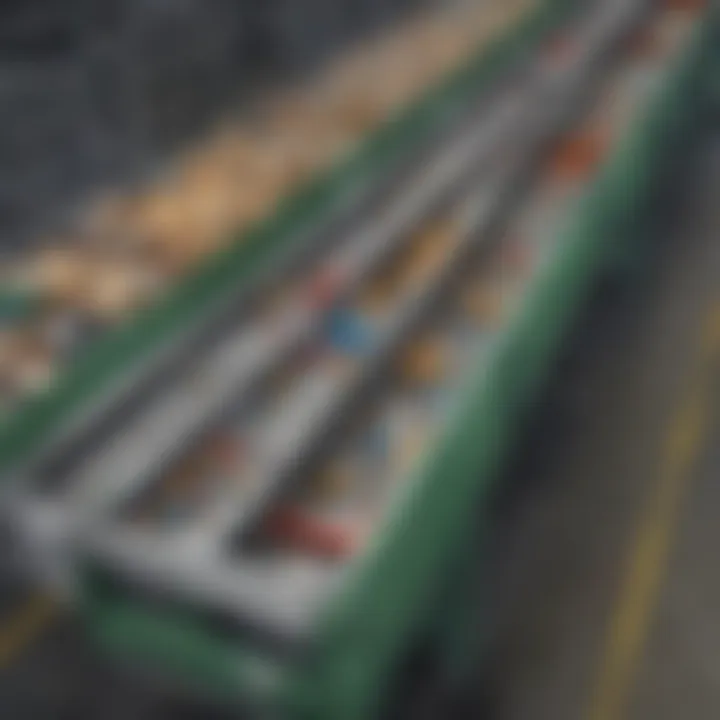Understanding the Sorting Mechanism in Recycling


Intro
Recycling is an essential part of sustainable living. It ensures that materials are reused instead of being thrown away, leading to less waste and a cleaner environment. However, the key to effective recycling lies in the sorting mechanism. Sorting recyclables is not just about throwing items into bins. It involves a complex system that includes various techniques and technologies to separate materials. To understand this process better, we look at how sorting works and its significance.
Science Fun Facts
Interesting Trivia and Facts
- Did you know that recycling one aluminum can saves enough energy to power a television for three hours?
- Plastic bottles can take up to 450 years to decompose in a landfill, making recycling crucial for environmental health.
- Approximately 69 million tons of paper products are recycled each year in the United States.
Quirky Science Stories
One story that captures the imagination involves a young boy who managed to turn his neighborhood into a cleaner space. By creating a competition among his friends on who could collect the most recyclables, he not only educated his peers on recycling's importance but also inspired others in the community to join in.
Amazing Science Records
The World’s Largest Plastic Bottle Sculpture was created in the Philippines using over 2,000 plastic bottles. This record was aimed at raising awareness about plastic waste and recycling efforts.
Thought-Provoking Questions
- How does the process of recycling affect our carbon footprint?
- What are some innovative ways to improve recycling habits in your local community?
Discover the Wonders of Science
Exploring Various Scientific Concepts
Understanding sorting mechanisms involves learning about material properties such as density, size, and magnetic properties. Such factors are crucial for deciding how machines will sort each item.
Educational Videos and Animations
There are numerous resources online, such as videos from YouTube, that detail the recycling process and demonstrate sorting techniques, allowing visual learners to grasp the topic more effectively.
Interactive Learning Tools
Websites like Britannica and Reddit often have interactive content that illustrates sorting processes and recycling facts, making it easier for younger audiences to understand.
Real-Life Applications of Science
The knowledge about sorting recycling can be applied in various settings, from home to schools and larger institutions. For example, schools can implement recycling programs that educate students while reducing waste.
Science Quiz Time
Interactive Quizzes
Engaging quizzes can reinforce knowledge about recycling. Here are a few quiz questions:
- What material cannot be recycled in regular bins? (Answer: Plastic bags)
- How many times can aluminum be recycled without losing quality? (Answer: Indefinitely)
Multiple Choice Questions
- What is the primary benefit of recycling? a) Less waste b) More landfill space c) Increased pollution Correct Answer: a)
- Which of these materials is not easily recyclable? a) Glass b) Cardboard c) Food waste Correct Answer: c)
Brain Teasers and Puzzles
Puzzle your mind to come up with creative recycling methods that your family can implement at home. Consider also how you can use everyday items to create new products instead of discarding them.
Learning Through Gamification
Gamifying the learning process can encourage participation. Educational platforms might offer games focused on recycling themes, helping to instill the importance of sorting and reusing materials while having fun.
Science Experiment Showcase
Fun and Engaging Experiments
An easy experiment is to create a simple recycling bin at home. Label different sections for paper, plastic, and metal. Track how much each member of the family recycles over a week.
Step-by-Step Instructions


- Gather materials to create bins using cardboard.
- Label each bin clearly – Paper, Plastics, Metals.
- Monitor and encourage family members to sort waste as they go.
Materials List
- Cardboard
- Markers
- Tape
Safety Tips and Precautions
Make sure to handle sharp objects used in recycling with care, and supervise children during the sorting process to ensure safety.
Prologue to Recycling
Recycling serves as a cornerstone of sustainable waste management. This practice allows materials that would typically end up in landfills to be repurposed and reused. Recycling benefits not only the environment by conserving resources and reducing pollution but also promotes a circular economy. A circular economy is one where resources are utilized to their fullest potential before being discarded. This shift in mindset is essential in modern times as the impact of waste on the planet becomes increasingly apparent.
Recycling helps minimize the depletion of natural resources. By reusing materials like plastics, metals, glass, and paper, we reduce the need to harvest new raw materials. Further, recycling helps in lowering greenhouse gas emissions. The energy saved by recycling is significant, contributing to a reduction in our overall carbon footprint.
In this article, we will explore how effective recycling and sorting of materials can enhance sustainability efforts. Understanding the recycling process is vital for fostering responsible behaviors among individuals and communities. The success of recycling programs hinges on awareness and participation, making knowledge a powerful tool in this endeavor.
The Importance of Recycling
Recycling is crucial for several reasons. Firstly, it alleviates the environmental burden. Waste in landfills can release harmful substances into the soil and waterways. By recycling, we divert waste from these areas. Secondly, recycling fosters economic growth. The recycling industry creates jobs and supports local economies. Additionally, the sale of recycled materials generates revenue.
Moreover, recycling promotes innovation. Advances in sorting technologies and recycling processes lead to better recovery rates of materials. The rise of initiatives focused on recycling urges communities to think about sustainability. Awareness campaigns educate the public about the importance of responsible waste disposal and recycling practices.
An Overview of the Recycling Process
The recycling process is intricate and involves several stages. Initially, materials are collected from various sources, such as homes, businesses, and recycling centers. This initial stage emphasizes the importance of proper sorting by collectors, as the quality of recycling greatly depends on the materials being separated correctly.
After collection, the next step is sorting. This ensures that materials are categorized correctly before processing. Sorting can take place at several locations, including material recovery facilities. The sorted materials then undergo cleaning and processing, making them suitable for remanufacturing into new products. Finally, the recycled materials are sold or shipped to manufacturers who can then create new products, closing the recycling loop.
Recycling is an ongoing cycle, where every element plays a critical role. Awareness about recycling helps in maintaining this cycle efficiently. Individuals and communities must recognize their contribution to the process and take active steps towards promoting recycling initiatives.
Types of Recyclable Materials
Understanding the various types of recyclable materials is crucial for an effective recycling process. Each material type has its characteristics and sorting requirements. This section will explore the four primary categories of recyclable materials: plastics, metals, glass, and paper. Knowing these categories helps in ensuring that materials are correctly sorted and processed, thus enhancing the efficiency of recycling efforts.
Plastics
Plastics are one of the most frequently encountered materials in our daily lives. They come in various forms, such as bottles, containers, and packaging. Not all plastics are the same; each type has a different recycling capability.
Commonly, plastics are categorized by their resin identification codes, from 1 to 7. For example, PETE or polyethylene terephthalate is marked with a 1, while HDPE or high-density polyethylene is marked with a 2. These codes indicate the type of plastic resin used and help recycling facilities decide the best way to process them.
Some types of plastics, like polyvinyl chloride (PVC), are less commonly recycled and can cause issues in the sorting process when mixed with other materials. By understanding the properties of different plastics, we can help improve the recycling rates and reduce plastic waste in our environment.
Metals
Metals are highly valuable in recycling due to their durability and ability to be reused indefinitely without loss of quality. Common recyclable metals include aluminum and steel. Aluminum cans, for example, represent a significant portion of the recyclable materials found in households.
The recycling of metals is economically beneficial. It requires less energy to recycle metals than to produce new ones from raw materials. Furthermore, aluminum recycling can save up to 95% of the energy needed for primary production. This advantage emphasizes the need to sort metals properly and send them to the appropriate recycling centers.
Glass
Glass is another essential recyclable material. It is inert, meaning it does not degrade and can be recycled endlessly. Glass jars, bottles, and containers are among the most common glass products that are recycled.
Sorting glass correctly is essential since different colors of glass require different processing methods. Clear, green, and brown glass are typically collected separately. When mixed, they can produce inferior quality recycled glass. Additionally, contaminants such as food residue can hinder the recycling process. This makes proper sorting and cleaning vital for effective recycling.
Paper
Paper products include newspapers, cardboard, and office paper. Recycling paper conserves trees, reduces landfill waste, and lowers greenhouse gas emissions. It requires less energy to recycle paper than to create new paper from trees.
However, paper is susceptible to contamination, mainly from food or grease, which affects its recyclability. It is essential to sort paper products properly, separating clean paper from items that can compromise the recycling process.
Recycling initiatives can be strengthened through proper education related to different recyclable materials and their significance. By having a clear understanding of these materials, individuals and communities can contribute significantly to improving recycling practices.
The Sorting Process
The sorting process serves as a crucial linkage between collection and recycling in any waste management regime. It is the phase where various recyclable materials are categorized for proper processing. Understanding this stage is not only important for recycling facilities but also for consumers who aim to enhance their contribution toward sustainable practices. Efficient sorting directly impacts the quality of the recycled material, thus influencing the market dynamics and environmental footprint.


Initial Collection
Initial collection encapsulates the moment waste is gathered from homes, schools, businesses, or public spaces. This stage sets the foundation for all subsequent sorting processes. It is vital that recyclable materials are collected accurately to improve the sorting efficiency later on. Poor collection practices often lead to contamination of materials, which makes the sorting process more difficult and less effective.
Simple practices can greatly enhance the initial collection. For instance, having separate bins for plastics, metals, glass, and paper fosters a culture of specific recycling behaviors among the community. Many local governments provide educational literature to inform the public about proper collection methods. This education is pivotal as it ensures cleaner loads, ultimately reducing issues during sorting.
Sorting Techniques
Sorting techniques can be classified into two primary categories: manual sorting and mechanical sorting. Each has its own unique operational principles and benefits. Both methods require considerable expertise to optimize the recycling process.
Manual Sorting
Manual sorting involves human operators who physically separate recyclable materials. This technique is particularly effective in identifying contaminated items that machines may overlook. Manual sorters can examine items closely, ensuring that only suitable materials progress to the next phase.
- Key Characteristic: The adaptability of manual sorting to complex waste streams is its main advantage. Trained personnel can easily recognize specific types of materials, which assures high-quality recycling output.
- Benefits: This approach offers high flexibility, enabling adjustments to sorting strategies based on varying waste compositions. Additionally, it fosters local job creation.
- Drawbacks: However, manual sorting can be labor-intensive and may lead to inconsistencies depending on the efficiency and training level of operators. Thus, while it is beneficial for complex waste, it is not scalable for larger operations.
Mechanical Sorting
Mechanical sorting utilizes machines and technology to categorize recyclable materials. These systems often incorporate various mechanisms such as conveyor belts, screens, and shredders, streamlining the process significantly. Efficiency is often the primary concern for recycling operations, and mechanical sorting addresses this concern effectively.
- Key Characteristic: The speed and scale at which mechanical sorting can operate is outstanding. High-capacity machines can process vast quantities of recyclables in a short time.
- Benefits: It reduces labor costs and enhances throughput, making it popular in large recycling facilities where volume is a crucial factor. Furthermore, advancements in technology have increasingly improved sorting accuracy.
- Drawbacks: The reliance on machinery may result in difficulties detecting contamination, especially in complex waste streams. Thus, a hybrid approach often emerges as the best solution, combining the strengths of both manual and mechanical sorting.
The effective sorting of recyclable materials is fundamental to reclaiming usable materials and reducing landfill waste. Each method has its benefits and limitations; understanding them helps improve the overall recycling process.
Advanced Sorting Technologies
Advanced sorting technologies play a crucial role in the efficiency and effectiveness of the recycling process. These technologies not only help separate different recyclable materials from one another but also significantly enhance the overall recycling rate by reducing contamination. In recycling, contamination refers to the presence of unwanted materials mixed with recyclables, which can complicate the sorting process and decrease the quality of recycled products. By utilizing modern sorting technologies, recycling facilities can minimize these issues and optimize resource recovery.
Optical Sorting
Optical sorting utilizes high-resolution cameras and sensors to identify and separate materials based on their physical properties. This method is particularly effective for sorting plastics, paper, and certain metals. Optical sensors detect specific wavelengths of light, allowing them to recognize various materials precisely. The data gathered is used to activate air jets that blow unwanted materials away from the recyclables, maintaining a higher purity rate.
Advantages of optical sorting include:
- Increased sorting efficiency
- Reduced labor costs
- Enhanced accuracy in material identification
Overall, optical sorting technology streamlines the recycling process while providing consistent results. However, it is essential to maintain the equipment and calibrate it regularly to achieve optimal performance.
Electromagnetic Sorting
Electromagnetic sorting relies on magnets to separate ferrous (magnetic) metals from recyclables. This technique is used widely in facilities that deal with both metals and other materials. The process begins with a conveyor belt transporting the mixed materials past a magnetic field. Ferrous metals are attracted to the magnets, while non-ferrous materials continue along the conveyor belt.
Some benefits of electromagnetic sorting include:
- Effective elimination of metals from waste streams
- High-speed processing
- The ability to handle large volumes of materials
Overall, electromagnetic sorting is a vital component in recycling to ensure that metals are efficiently extracted and recycled, contributing to a sustainable circular economy.
AI in Recycling
Artificial Intelligence (AI) is making significant strides in the recycling industry, paving the way for smarter sorting solutions. AI algorithms analyze data from sorting systems to identify patterns and optimize sorting processes. Through machine learning, AI can improve its efficiency over time, allowing for quicker and more accurate sorting of various materials.
Some key advantages of incorporating AI in recycling include:
- Enhanced operational efficiency
- Reduced human error
- The ability to adapt to new materials or sorting challenges
AI-driven robotics in recycling facilities can even take on the manual sorting tasks, tackling them with greater speed and efficiency than human workers. This technology ensures better overall contamination control and enables recyclers to focus their efforts on other essential tasks.
"Adopting cutting-edge sorting technologies in recycling is an investment in a cleaner and more sustainable future."
By understanding these technologies, we can appreciate their significant contribution to effective recycling practices.
Challenges in Recycling Sorting
Recycling sorting is a critical aspect of the recycling process that ensures materials are properly categorized and processed. However, several challenges hinder its efficiency. Understanding these challenges is essential to improve recycling practices. The key challenges include contamination issues and market demand fluctuations, both of which affect the sorting process significantly.
Contamination Issues
Contamination occurs when non-recyclable materials are mixed with recyclable materials. This can impact the quality of recyclables and hamper the sorting process. For example, when plastics are contaminated with food residue, it makes it much harder for facilities to recycle those items. Consequently, contaminated loads may end up in landfills instead of being processed for recycling.
It is crucial for consumers to understand what can and cannot be recycled. Educating the public on proper sorting methods can mitigate the risk of contamination. Here are a few points about contamination:


- Impact on Quality: Contaminated materials can lead to lower quality of recycled products. This reduces the value of these materials.
- Increased Costs: More time and resources are spent to clean contaminated materials, which can lead to higher processing costs.
- Inefficiency: When workers sort through contaminated materials, it slows down the entire operation.
"Reducing contamination at the source is more effective than cleaning it on the back end."
Market Demand Fluctuations
Fluctuations in market demand for recycled materials present another significant challenge in recycling sorting. Recycling facilities depend on the sale of recyclables to cover operational costs. When market demand drops, facilities may not have enough income to sustain their operations. This leads to several outcomes:
- Limited Processing Capacity: Facilities may operate below capacity, reducing the amount of materials they can process.
- Stockpiling of Recyclables: When demand decreases, recyclables can pile up, occupying space and leading to potential degradation of materials.
- Changing Recyclables Landscape: As new materials enter the market, recycling facilities must adapt quickly. Not all countries have updated their regulations for these materials, leading to potential confusion.
Understanding the challenges in recycling sorting helps emphasize the importance of proper consumer practices and the need for constant improvements in recycling technology and policies. Addressing these challenges is essential for maximizing recycling efforts and promoting sustainability.
The Role of Consumers
The role of consumers in recycling is a vital aspect of the entire recycling process. Their actions directly influence the effectiveness of the sorting mechanisms and the ultimate success of recycling programs. As individuals, consumers have the potential to make significant contributions to sustainability through their everyday choices and behaviors.
One important element regarding consumer responsibility is proper recycling practices. When consumers know how to recycle correctly, they help ensure that recyclable materials are sorted efficiently. This understanding can minimize contamination that often leads to recyclable items being sent to landfills instead of being processed. The benefits of proper recycling practices extend beyond individual households; they contribute to the effectiveness of community-wide recycling efforts.
Proper Recycling Practices
Proper recycling practices start with understanding what materials can be recycled and how to prepare them for collection. Here are some key guidelines:
- Clean and Rinse: Before placing recyclables in the bin, it's essential to rinse out containers to remove food residue. Contaminants can ruin entire batches of recyclables.
- Separate Materials: Consumers should know which materials belong together. For instance, plastic bottles should be separated from glass jars.
- Follow Local Guidelines: Different areas have different recycling rules. Checking local guidelines helps ensure compliance with specific regulations.
Properly following these practices enhances the efficiency of sorting facilities and reduces the risk of contamination. Thus, consumers need to stay informed and actively participate in recycling initiatives.
Awareness and Education
Awareness and education regarding recycling are critical for fostering a culture of sustainability. When consumers are educated about the recycling process, they tend to recycle more responsibly and effectively. Education can take many forms, including community workshops, school programs, and online resources.
Understanding the recycling flow from collection to sorting can make consumers more mindful about their waste. When they realize how much effort goes into sorting materials, they may be more likely to engage in better recycling habits.
"Education is the most powerful weapon which you can use to change the world."
— Nelson Mandela
Moreover, educational campaigns can emphasize the environmental impacts of recycling. They highlight how recycling reduces waste in landfills and conserves natural resources. This knowledge fosters a sense of ownership and accountability, encouraging individuals to play an active role in their communities.
Future of Recycling and Sorting
The future of recycling and sorting is crucial to improving overall waste management systems. As the global population grows, so does the need for efficient recycling. Effective sorting systems help ensure that recyclable materials are processed correctly. This contributes to sustainable practices and reduces landfill waste.
Innovations in Sorting Technology
Technology plays a significant role in shaping the future of recycling. New sorting technologies emerge regularly. These innovations aim to increase efficiency and accuracy in the sorting process. For example, robotic systems can identify and sort materials faster than human workers. They utilize visual recognition to determine different types of plastics or metals.
Optical sorting systems are also advancing. They use light beams to distinguish materials based on color and composition. This helps enhance the quality of sorted recyclables. The integration of artificial intelligence in sorting machines brings even more potential. AI systems learn from loads of data, improving their sorting decisions over time.
Sustainability Goals
Sustainability is at the heart of modern recycling initiatives. The quest for a sustainable future is not just about sorting waste, but also about ensuring that materials are recycled in an eco-friendly way. Setting clear sustainability goals helps organizations measure progress and modify practices when necessary.
Reducing the carbon footprint of recycling operations is a primary goal. By optimizing sorting processes, facilities can operate more efficiently, which reduces energy consumption. This is vital in combating climate change and managing resources responsibly.
Additionally, promoting the use of recycled materials in production helps close the recycling loop. This is essential for industries to depend less on virgin materials, minimizing environmental impact.
"The essential promise of recycling is not just to reuse but to rethink our approach to materials."
Encouraging consumer awareness and responsibility is also crucial. Individuals can contribute to sustainability efforts by recycling properly and advocating for better sorting systems. By fostering a collective understanding of the importance of recycling, we can all participate in a brighter ecological future.
The End
The conclusion serves as a crucial wrap-up for the exploration of recycling sorting mechanisms. It brings together all critical ideas discussed in the article and highlights their significance. The core focus lies in linking the systematic approach to materials sorting with the broader mission of sustainability. This connection is not merely for academic purposes, but it emphasizes how effective sorting methods can significantly influence recycling outcomes.
Effective sorting directly affects the quality of recycled materials. When materials are accurately separated, it allows recycling plants to process them more efficiently. This translates into higher yield rates of usable materials, which can effectively reduce waste. Moreover, communities that engage in proper sorting practices contribute to lower overall disposal costs and less environmental strain. Therefore, the conclusion underscores the real-world implications of improved recycling systems on our environment.
Additionally, the information presented throughout the article encourages informed decisions among consumers. Understanding the sorting process empowers individuals to participate actively in recycling efforts. This active participation is essential as every step in recycling can lead to more significant collective outcomes. The final thoughts on recycling are not simply about reducing waste, but also fostering a culture of sustainability that begins at the individual level and scales to communities and beyond.
By acknowledging the importance of sorting in recycling, we further underline the responsibility each of us holds in protecting our planet for future generations. Thus, as we conclude this discussion, the call is clear: we must, together, refine our recycling habits and uphold the importance of sorting for a sustainable future.
"Recycling isn't just a process; it's a commitment to our planet's health."
Final Thoughts on Recycling
Recycling is a multifaceted practice that is essential for environmental conservation. As we have seen, the intricacies involved in sorting recyclable materials play a significant role in this endeavor. With a growing understanding of how different materials are treated and processed, consumers can be better equipped to make impactful choices in their everyday lives.
It's also imperative to stay informed about the latest advancements in sorting technology. Each innovation brings new possibilities for enhancing efficiency and effectiveness in recycling facilities. Furthermore, community education programs can also be crucial. They not only inform households about proper sorting techniques but also inspire a collective commitment to sustainable practices.







